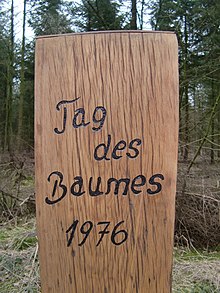Bürsteler Fuhrenkamp
|
Bürsteler Fuhrenkamp
IUCN Category Category VI - |
||
|
The Bürsteler Fuhrenkamp on the other side of the railway line |
||
| location | Oldenburger Land , Lower Saxony | |
| surface | 60.8 ha | |
| Geographical location | 53 ° 1 ' N , 8 ° 32' E | |
|
|
||
| Setup date | 1976 | |
The Bürsteler Fuhrenkamp , also known as Bürsteler Fuhren or simply Fuhrenkamp , is a 60.8 hectare forest area in the Oldenburg district in Lower Saxony .
geography
The Bürsteler Fuhrenkamp borders on Ganderkesee to the southwest . It belongs to the village of Bürstel , but has been separated from it by the Delmenhorst – Hesepe railway since 1898 . The ground consists of inland dunes .
history
The forest area was only created in 1780 by reforestation with pine trees on the inland dunes to consolidate the sand.
As early as the Second World War , there was a forest kindergarten with a barracks at Bürsteler Fuhrenkamp, which was separated by an earth wall . This was in the northeast corner at the end of the path there. Most recently, until around 1960, it was privately inhabited.
On November 13, 1972, the storm Quimburga , which swept over parts of the Oldenburg region at almost 200 km / h , destroyed large parts of the Bürsteler Fuhrenkamp. Only about a fifth of the pine forest remained. It was not until 1975 that all the fallen trees were cleared. On March 27, 1976 on Tree Day, the Stühe district forester and the Ganderkesee local and local community organized a large planting event in which over 500 schoolchildren planted around 3,000 trees. A wooden plaque was set up on the edge of the Bürsteler Fuhrenkamp to commemorate this day.
A southern bypass around Ganderkesee was planned around 2002 , which might also have affected the Bürsteler Fuhrenkamp. The Fuhrenkamp Protection Association , which still exists today , was formed from a citizens' initiative .
In June 2012 there were public protests against the road construction planned by the Lower Saxony State Forests in Fuhrenkamp and the subsequent graveling of the roads. As a compromise, it was agreed that the character of the sandy paths would be preserved.
present
The forest has been designated as a landscape protection area under the number OL 00016 since 1976 . In addition to Scots pine , spruce , Douglas fir and larch , oaks and hornbeams also grow there today . The forest is used for forestry and serves the residents of the surrounding villages as a recreational area .
In the spring of 2015, the Lower Saxony State Forests felled around 115-year-old pines, which were replaced by 12,000 50 to 80 centimeter tall red oaks in winter . The aim of the new planting is to switch from softwood to hardwood.
Individual evidence
- ↑ Ganderkesee in wartime , Werner Lüdeke and Hermann Speckmann, Ganderkesee 2017.
- ↑ Memories of Storm Quimburga , accessed on November 6, 2014.
- ^ Protest against road construction in Fuhrenkamp , accessed on November 6, 2014.
- ↑ Compromise on sand paths under Douglas fir , accessed on November 6, 2014.
- ↑ 12,000 red oaks for the Fuhrenkamp in Ganderkesee , accessed on August 25, 2019.



